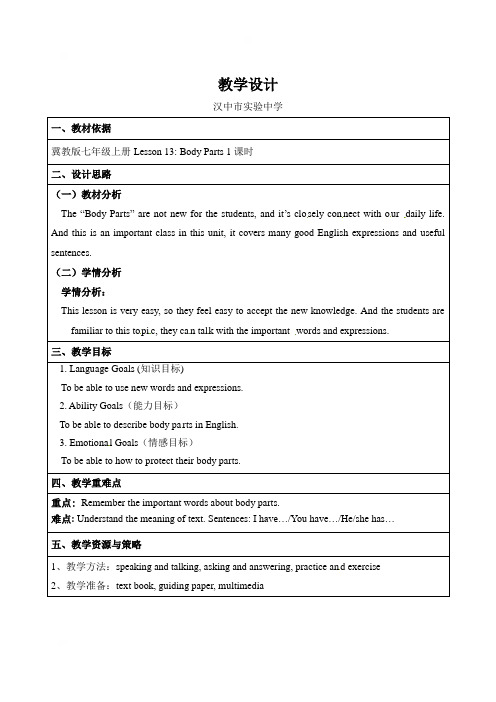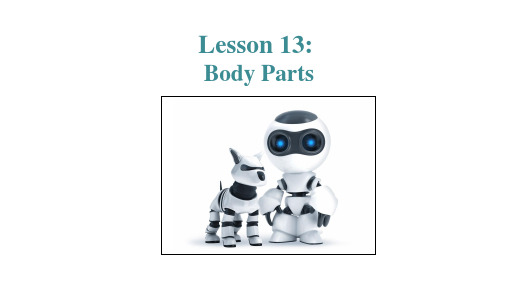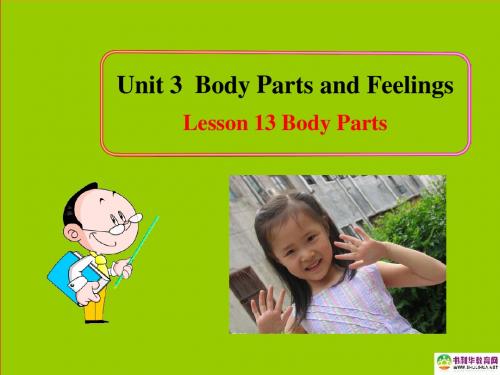七年级英语上册Unit3Lesson13BodyParts导学案(无答案)(新版)冀教版
- 格式:doc
- 大小:123.50 KB
- 文档页数:4


教学设计汉中市实验中学一、教材依据冀教版七年级上册Lesson 13: Body Parts 1课时二、设计思路(一)教材分析The “Body Parts” are not new for the students, and it’s clo sely con nect with o ur daily life. And this is an important class in this unit, it covers many good English expressions and useful sentences.(二)学情分析学情分析:This lesson is very easy, so they feel easy to accept the new knowledge. And the students are familiar to this topi c, they ca n talk with the important words and expressions.三、教学目标1. Language Goals (知识目标)To be able to use new words and expressions.2. Ability Goals(能力目标)To be able to describe body pa rts in English.3. Emotional Goals(情感目标)To be able to how to protect their body parts.四、教学重难点重点: Remember the important words about body parts.难点: Understand the meaning of text. Sentences: I have…/You have…/He/she has…五、教学资源与策略1、教学方法:speaking and talking, asking and answering, practice an d exercise2、教学准备:text book, guiding paper, multimedia五、教学过程教学环节教师活动学生活动设计意图Step 1 Lead-in Listen to an Engli sh song to leadto the new lesson.Sing the song and dosome actionsDraw students’attention.Step 2 Learning Objectives Show the learning objectives. Read aloud together. Make studentsknow what theywill learn in thislesson.Step 3 Listening 1. Give questions before listening.2. Listen to the tape together.Li sten and answer thequestions.Improve theirs kills of solvingproblems.Step 4 Reading 1. Give questions before reading.2. Read the text together andanswer the questions.Read and answer thequestions.Improve theirreading skills.Step 5 Exercise Let students introduce their bodyparts with phrases“I have…;He/shehas…”Introduce their bodyparts with the correctsentence patternsOutput partStep 6 Guessing Game 1. Show picture of a student, pointhis b ody parts and let th em guesswho is he.2. Finish the exercise 3 on Page37.Finish the guessinggame.Arousing theirinterests of bodypartsStep 7HomeworkFinish English Weekly of Lesson 13.六、板书设计。




冀教版英语精品资料(精修版)新冀教版七年级上册Unit3课文重点整理(Lessons 13-15)Unit 3: Body Parts and FeelingsLesson 13: Body Parts1、两只大眼睛____________________ 说英语________________________我的长胳膊____________________ 做面条________________________两只大脚______________________ 和我玩儿______________________do my homework________________ righthand______________________a football player_________________ talk with the mouth_______________2、 I can speak English and Chinese. 我能说英语和汉语。
句中的speak与say,tell有何区别?①speak在此处作及物动词,用于表示说、讲某种语言时,意为“讲、说”。
例如:你会讲汉语吗? ______________________________②say是及物动词,后接说话的内容作宾语,但不能直接跟某人作宾语,只能说say to sb.。
例如:你最好跟她道个歉。
You’d better __________________ her.③talk意为“谈论、说”,是不及物动词,常用于talk to / with sb.;talk about sth. / sb. 短语中。
例如:他和我谈论了那个电影。
He talked ______ me ______ the film.3、 I have ten fingers—just like you! 我有十根手指—就像你一样!like在句中作介词,意思是“像;如”。
1
Body Parts
课题 Lesson 13: Body Parts 时间
主备人 授课人 班级 审核人
阶段 环节 教学过程 教师活动 学生活
动
第
一
阶
段
预
学
案
目标 导航 学习 目标 掌握重点单词: part, feeling, robot, camera, smell, finger, player, homework 掌握重点短语:make noodles, a football player 向学生明确目标 明确这
节课该
干什么
自主
预习
掌握本课单词和短语的读法,并能了解文章大意。 自学
预习
自测
预习反
馈:
(2-3mi
ns)
一、英汉互译
1. feeling _______________
2. smell __________________
3. 照相机 ________________
4. like to do sth. _________________
5. 做作业 _________________
6. make noodles _________________
二、完成课后第二题。
一、检查单词及词组的读法并校正。
二、汉译英
1.我有两只大眼睛。
________________________
2.你想跟我一起玩吗?
________________________
3.我没有耳朵但我能听到你。
________________________
三、拓展练习
讨论一:I have one nose.(变为否定句)
.
教师领读 教师验收预习效果 从课本查阅完成练习 学生跟
读
学生作
答
2
第 二 阶 段 教 学 案 合作 探究: 交流 展示: 精讲 点拨: (25mins ) 达标测试: (8min ) 讨论二:I can make noodles with my long arms. (变为否定句和一般疑问句) ___________________________. _______________________________? 合作探究:(10mins) Task 1:小组读课文弄懂文章大意,并找出课文中所涉及的短语和句型。 Task 2:教师播放听力录音,学生完成Let’s Do It 1。 Task 3:学生小组讨论猜谜,完成Let’s Do It 3。 交流展示:(5mins) 1.展示课文中所涉及的短语和句型。 2.展示Let's Do It 1-3的答案。 3.教师播放录音,学生根据录音做出指定动作,完成Let’s Do It 4。 精讲点拨:(10mins) 1.I can see with them. 知识点:with的用法。 2.I have two big eyes. 知识点:动词have的用法。 3.I don’t have ears but I can hear you. 知识点:否定句的结构 单项选择 1. They are playing basketball ______ my brother. A. at B. on C. in D. with 巡视 指导 订正答案耐心讲解 教师讲解本节课重难点 教师 巡视 学生小组讨论交流 先独立
完成再
与组员
订对答
案
学生理
解记忆
学生独
立完成
练习
3
第 三 阶 段 检 测 案
巩固
提升
(8min)
教学
反思
2. A rainbow comes________ after the rain. High ________ the sky. A. out, out B. in, in C. out, in D. in, out 3. What do you want to ________? A. eat B. eats C. to eat D. eating 4. What can you _________ in the picture? A. look B. see C. watch D. look at 5. — _________ students are there in your class? — forty-one. A. How much B. How many C. How long D. How far 句型转换 1. My name is Robin. (改为同义句) __________ ___________ Robin. 2.I can speak English and Chinese. (对划线部分提问) __________ __________ you speak? 3.My favourite colour is black. (对划线部分提问) ______ _______ favourite colour? 4.Are you a basketball player? (作否定回答) No, ________ ___________. 5.I can do your homework.. (改为否定句) I __________ _________ your homework.
参考答案:
预习自测 一、1.感觉;情感 2.闻起来 3.camera 4.喜欢做
5.do homework 6.做面条
二、略
4
预习反馈 二、1.I have two big eyes.
2.Do you want to play with me?
3.I don’t have ears but I can hear you.
三、1.I don’t have nose.
2.I can’t make noodles with my long arms.
Can you make noodles with your long arms?
达标测试:1-5 DCABB
巩固提升: 1.I’m
2.What can
3.What’s your
4.I’m not
5.can’t do